Magnetic Hardening of Heavily Helium-Ion-Irradiated Iron–Chromium Alloys
Abstract
1. Introduction
2. Experimental Procedures
2.1. Specimen Preparation
2.2. Characterization of Microstructure and Magnetism
3. Results
3.1. Epitaxial Structure and Lattice Expansion
3.2. Formation of Cavities
3.3. Irradiation Effects on Magnetization Curves
4. Discussion
5. Conclusions
- (1)
- The helium irradiation did not affect the crystal structure and orientation of epitaxially grown films.
- (2)
- In all specimens, an approximate 1% increase in the lattice distance perpendicular to the film plane was confirmed. Furthermore, small high-density cavities with a similar number density were observed in both Fe and Fe-20%Cr films.
- (3)
- After irradiation, significant magnetic hardening was observed in the magnetization curves of Fe-10%Cr and 20%Cr films, whereas no change was confirmed in the Fe film. The saturation magnetic field of Fe-20%Cr reached around 1 kOe.
- (4)
- The magnetization curve of the irradiated Fe-20%Cr film can be decomposed into two components: one characterized by low coercivity and hard magnetization, and the other exhibiting high coercivity and a rectangular shape.
- (5)
- The magnetic hardening in iron–chromium alloys is believed to be caused by cavity formation and rearrangement of chromium atoms induced by irradiation.
Author Contributions
Funding
Data Availability Statement
Acknowledgments
Conflicts of Interest
References
- Cabet, C.; Dalle, F.; Gaganidze, E.; Henry, J.; Tanigawa, H. Ferritic-martensitic steels for fission and fusion applications. J. Nucl. Mater. 2019, 523, 510–537. [Google Scholar] [CrossRef]
- Bhattacharya, A.; Zinkle, S.J.; Henry, J.; Levine, S.M.; Edmondson, P.D.; Gilbert, M.R.; Tanigawa, H.; Kessel, C.E. Irradiation damage concurrent challenges with RAFM and ODS steels for fusion reactor first-wall/blanket: A review. J. Phys. Energy 2022, 4, 034003. [Google Scholar] [CrossRef]
- Roccella, R.; Boccaccini, L.V.; Meyder, R.; Raff, S.; Roccella, M. Assessment of EM loads on the EU HCPB TBM during plasma disruption and normal operating scenario including the ferromagnetic effect. Fusion Eng. Des. 2008, 83, 1212–1216. [Google Scholar] [CrossRef]
- Kim, D.H.; Oh, D.K.; Pak, S.; Jhang, H.; Lee, J.; Rozov, V. Eddy current induced electromagnetic loads on shield blankets during plasma disruptions in ITER: A benchmark exercise. Fusion Eng. Des. 2010, 85, 1747–1758. [Google Scholar] [CrossRef]
- Knaster, J.; Moeslang, A.; Muroga, T. Materials research for fusion. Nat. Phys. 2016, 12, 424–434. [Google Scholar] [CrossRef]
- Abromeit, C. Aspects of simulation of neutron damage by ion irradiation. J. Nucl. Mater. 1994, 216, 78–96. [Google Scholar] [CrossRef]
- Papamihail, K.; Mergia, K.; Ott, F.; Serruys, Y.; Speliotis, T.; Apostolopoulos, G.; Messoloras, S. Magnetic effects induced by self-ion irradiation of Fe films. Phys. Rev. B 2016, 93, 100404(R). [Google Scholar] [CrossRef]
- Novy, S.; Pareige, P.; Pareige, C. Atomic scale analysis and phase separation understanding in a thermally aged Fe-20 at.% Cr alloy. J. Nucl. Mater. 2009, 384, 96–102. [Google Scholar] [CrossRef]
- Mohapatra, J.N.; Kamada, Y.; Kikuchi, H.; Kobayashi, S.; Echigoya, J.; Park, D.G.; Cheong, Y.M. Evaluation of embrittlement in isochronal aged Fe-Cr alloys by magnetic hysteresis loop technique. J. Magn. 2011, 16, 173–176. [Google Scholar] [CrossRef]
- Vojtech, V.; Charilaou, M.; Kovács, A.; Firlus, A.; Gerstl, S.S.; Dunin-Borkowski, R.E.; Löffler, J.F.; Schäublin, R.E. Macroscopic magnetic hardening due to nanoscale spinodal decomposition in Fe–Cr. Acta Mater. 2022, 240, 118265. [Google Scholar] [CrossRef]
- Soisson, F.; Jourdan, T. Radiation-accelerated precipitation in Fe–Cr alloys. Acta Mater. 2016, 103, 870–881. [Google Scholar] [CrossRef]
- Zhao, Y.; Bhattacharya, A.; Pareige, C.; Massey, C.; Zhu, P.; Poplawsky, J.D.; Zinkle, S.J. Effect of heavy ion irradiation dose rate and temperature on α′ precipitation in high purity Fe-18% Cr alloy. Acta Mater. 2022, 231, 117888. [Google Scholar] [CrossRef]
- Kamada, Y.; Watanabe, H.; Mitani, S.; Mohapatra, J.N.; Kikuchi, H.; Kobayashi, S.; Mizuguchi, M.; Takanashi, K. Ion-irradiation enhancement of materials degradation in Fe-Cr single crystals detected by magnetic technique. J. Nucl. Mater. 2013, 443, S861–S864. [Google Scholar] [CrossRef]
- Mergia, K.; Tsompopoulou, E.O.; Dellis, S.; Marrows, C.H.; Michelakaki, I.; Kinane, C.; Cauana, A.; Langridge, S.; Douvalis, A.P.; Cabet, C.; et al. Phase stability of Fe-5at%Cr and Fe-10at%Cr films under Fe+ ion irradiation. J. Phys. Condens. Matter 2020, 32, 185702. [Google Scholar] [CrossRef] [PubMed]
- Pantousa, S.; Mergia, K.; Ionescu, A.; Manios, E.; Dellis, S.; Kinane, C.; Langridge, S.; Cauana, A.; Kentsch, U.; Messoloras, S. Fe+ ion irradiation effects in Fe-10at%Cr films irradiated at 300 °C. Nucl. Mater. Energy 2022, 30, 101147. [Google Scholar] [CrossRef]
- Qiu, S.; Liu, H.; Jiang, M.; Min, S.; Gu, Y.; Wang, Q.; Yang, J.; Li, X.; Chen, Z.; Hou, J. A Brief Review on He Ion Irradiation Research of Steel and Iron-Based Alloys in Nuclear Power Plants. Acta Metall. Sin. (Engl. Lett.) 2023, 36, 529–551. [Google Scholar] [CrossRef]
- Bhattacharya, A.; Zinkle, S.J. Cavity Swelling in Irradiated Materials. In Comprehensive Nuclear Materials, 2nd ed.; Konings, R., Stoller, R.E., Eds.; Elsevier: Amsterdam, The Netherlands, 2020; Volume 1, pp. 406–455. [Google Scholar]
- Kamada, Y.; Umeyama, D.; Oyake, T.; Murakami, T.; Shimizu, K.; Fujisaki, S.; Yoshimoto, N.; Ohsawa, K.; Watanabe, H. Microstructure and Magnetism of Heavily Helium-Ion Irradiated Epitaxial Iron Films. Metals 2023, 13, 1905. [Google Scholar] [CrossRef]
- Ziegler, J.F.; Ziegler, M.D.; Biersack, J.P. SRIM—The stopping and range of ions in matter (2010). Nucl. Instrum. Methods Phys. Res. B 2010, 268, 1818–1823. [Google Scholar] [CrossRef]
- Bozorth, R.M. Ferromagnetic Materials; IEEE Press: New York, NY, USA, 1993. [Google Scholar]
- Mörée, G.; Leijon, M. Review of Hysteresis Models for Magnetic Materials. Energies 2023, 16, 3908. [Google Scholar] [CrossRef]
- Takács, J. A phenomenological mathematical model of hysteresis. COMPEL Int. J. Comput. Math. Electr. Electron. Eng. 2001, 20, 1002–1015. [Google Scholar] [CrossRef]
- Guedes, I.; Zaluzec, N.J.; Grimsditch, M.; Metlushko, V.; Vavassori, P.; Ilic, B.; Kumar, R. Magnetization of negative magnetic arrays: Elliptical holes on a square lattice. Phys. Rev. B 2000, 62, 11719. [Google Scholar] [CrossRef]
- Vavassori, P. Arrays of ferromagnetic dots and antidots. In La Rivista del Nuovo Cimento; Springer: Berlin/Heidelberg, Germany, 2002; Volume 25, pp. 1–39. [Google Scholar]
- Ono, K.; Arakawa, K.; Hojou, K. Formation and migration of helium bubbles in Fe and Fe-9Cr ferritic alloy. J. Nucl. Mater. 2002, 307–311, 1507–1512. [Google Scholar]
- Hao, W.; Geng, W.T. Understanding Cr segregation at the He bubble surface in Fe. J. Phys. Condens. Matter 2012, 24, 095009. [Google Scholar] [CrossRef] [PubMed]
- Hall, R.C. Single-Crystal Magnetic Anisotropy and Magnetostriction Studies in Iron-Base Alloys. J. Appl. Phys. 1960, 31, 1037–1038. [Google Scholar] [CrossRef]
- Dieny, B.; Gavigan, J.P.; Rebouillat, J.P. Magnetisation processes, hysteresis and finite-size effects in model multilayer systems of cubic or uniaxial anisotropy with antiferromagnetic coupling between adjacent ferromagnetic coupling between adjacent ferromagnetic layers. J. Phys. Condens. Matter 1990, 2, 159–185. [Google Scholar] [CrossRef]
- Wang, X.; Hatzoglou, C.; Sneed, B.; Fan, Z.; Guo, W.; Jin, K.; Poplawsky, J.D. Interpreting nanovoids in atom probe tomography data for accurate local compositional measurements. Nat. Commun. 2020, 11, 1022. [Google Scholar] [CrossRef]
- Dubiel, S.M.; Żukrowski, J.; Serruys, Y. Effect of 0.25 and 2.0 MeV He-ion irradiation on short-range ordering in model (EFDA) Fe-Cr alloys. Metall. Mater. Trans. A 2018, 49, 3729–3737. [Google Scholar] [CrossRef]

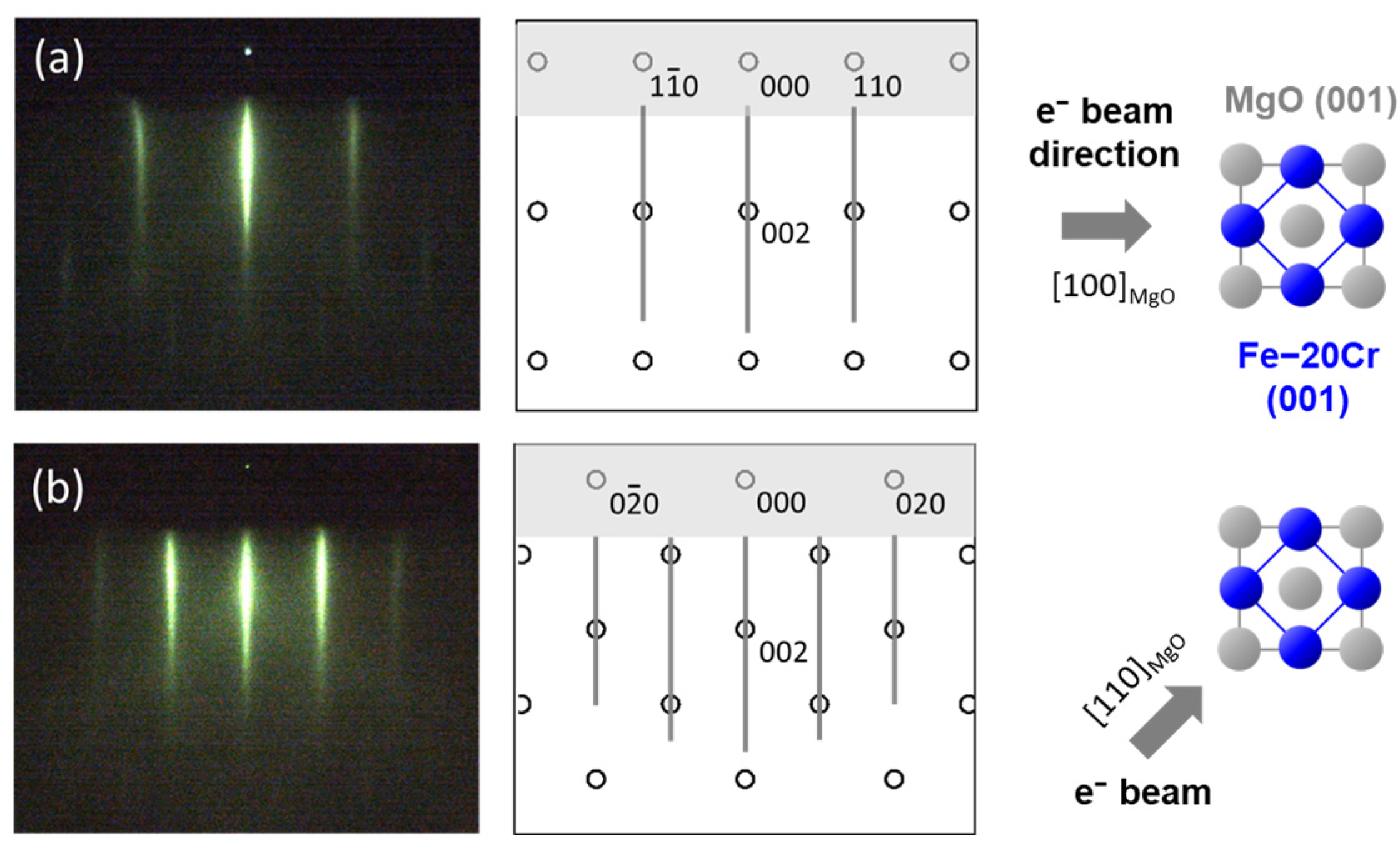
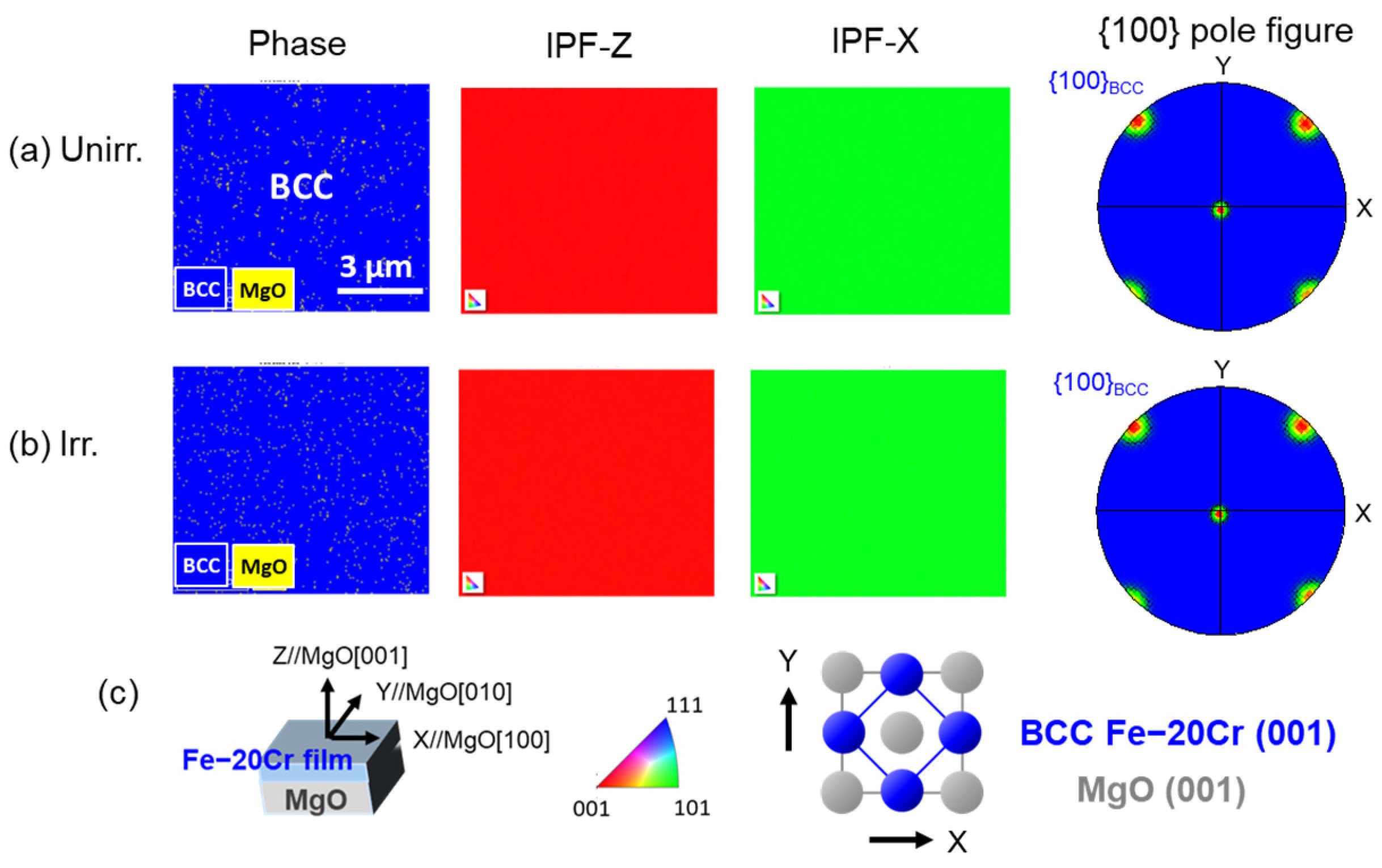
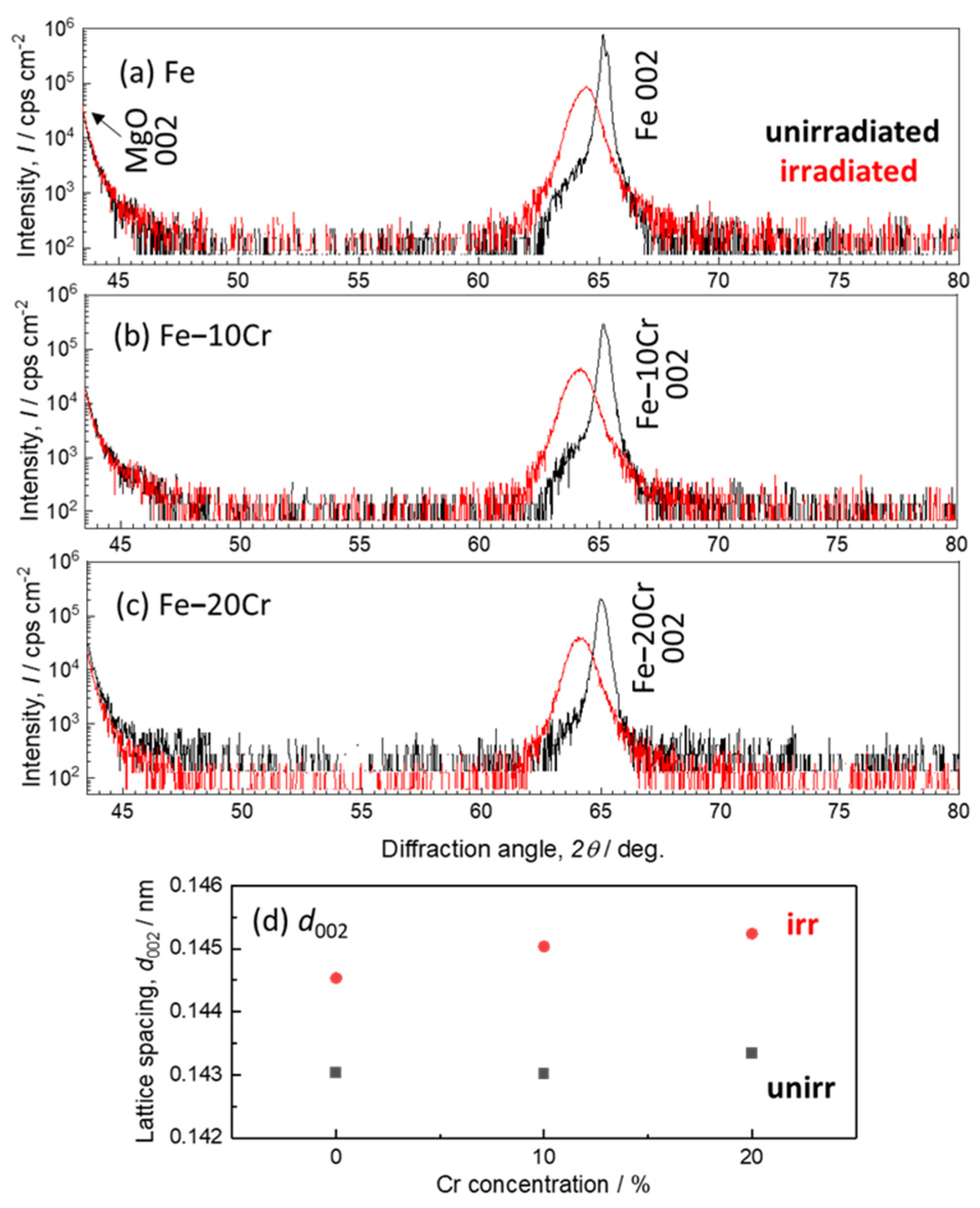
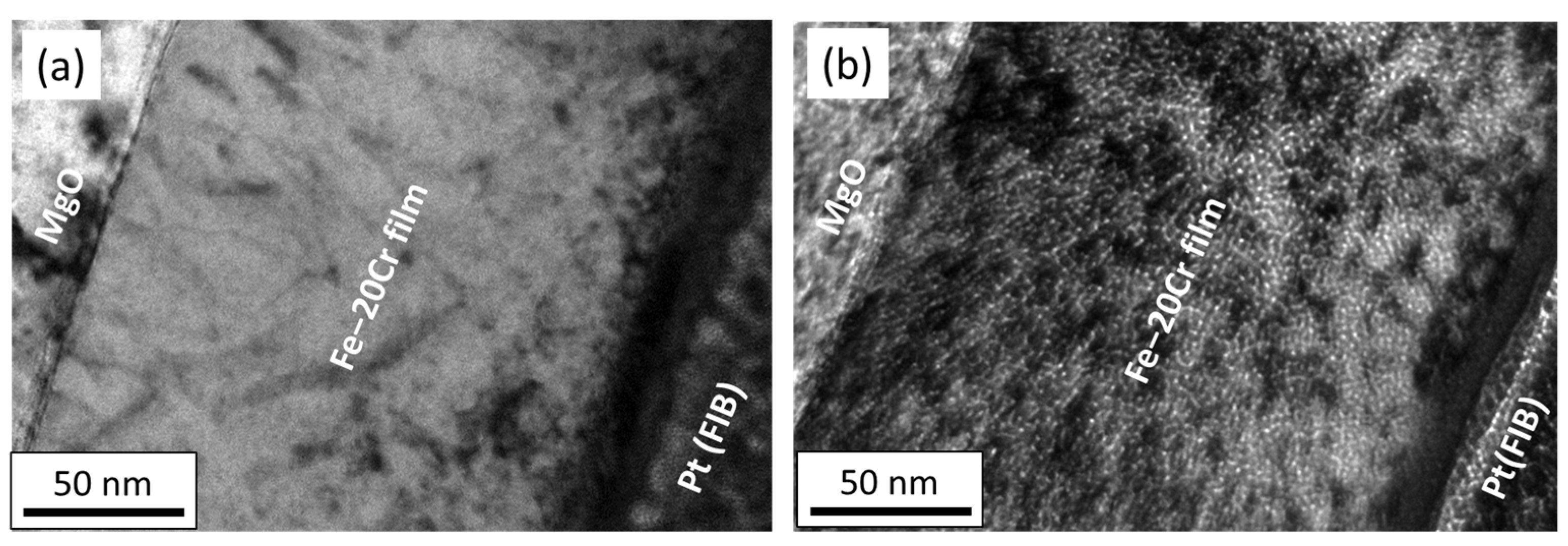



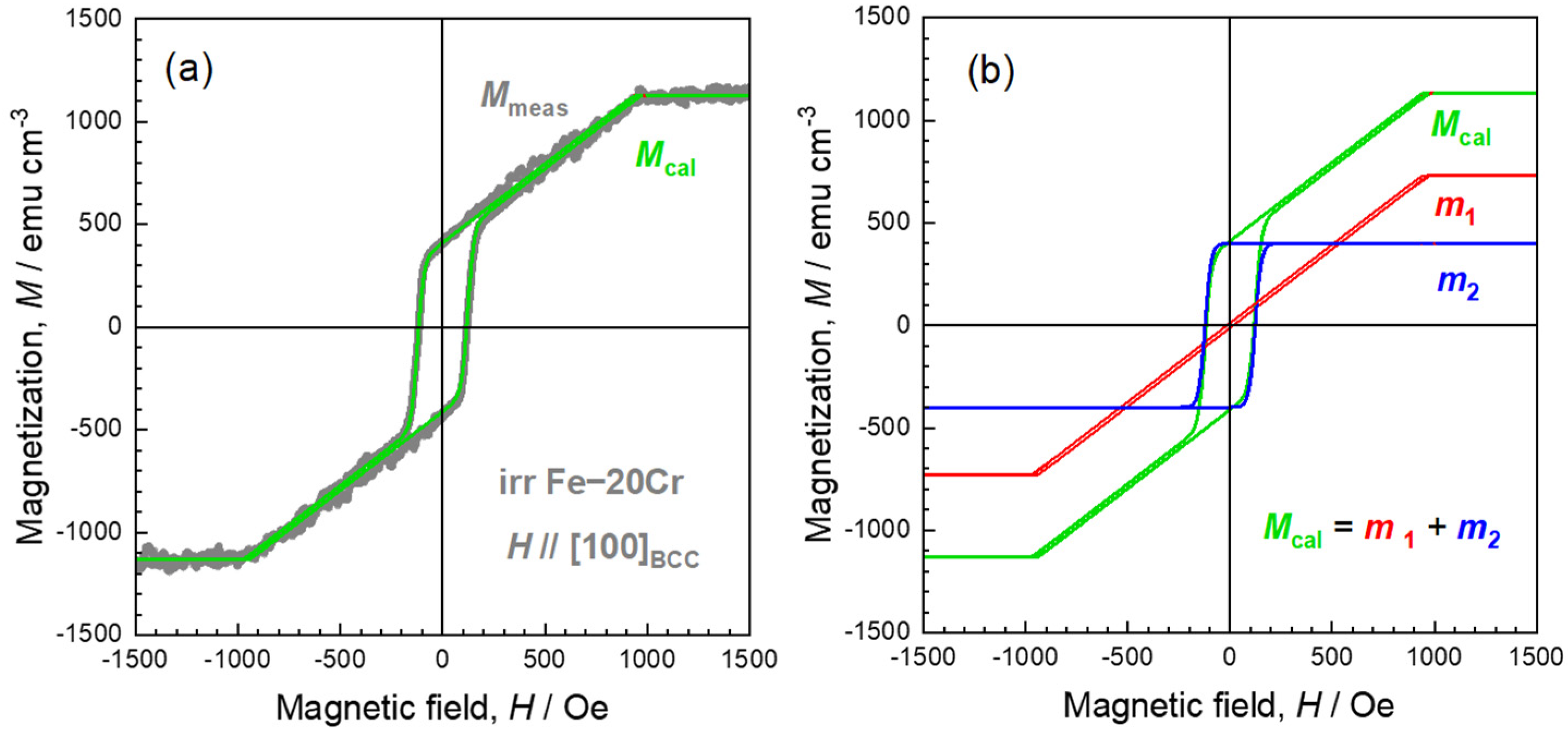
| Fe | Fe-10%Cr | Fe-20%Cr | |
|---|---|---|---|
| Ms (emu/cm3) | 1.63 × 103 | 1.39 × 103 | 1.13 × 103 |
| K1 (erg/cm3) | 4.8 × 105 | 3.4 × 105 | 1.8 × 105 |
| (Oe) | (Oe) | |||
|---|---|---|---|---|
| 1 | 0.65 | 15 | 3 | 1.3 |
| 2 | 0.35 | 123 | 30 | 0 |
Disclaimer/Publisher’s Note: The statements, opinions and data contained in all publications are solely those of the individual author(s) and contributor(s) and not of MDPI and/or the editor(s). MDPI and/or the editor(s) disclaim responsibility for any injury to people or property resulting from any ideas, methods, instructions or products referred to in the content. |
© 2024 by the authors. Licensee MDPI, Basel, Switzerland. This article is an open access article distributed under the terms and conditions of the Creative Commons Attribution (CC BY) license (https://creativecommons.org/licenses/by/4.0/).
Share and Cite
Kamada, Y.; Umeyama, D.; Murakami, T.; Shimizu, K.; Watanabe, H. Magnetic Hardening of Heavily Helium-Ion-Irradiated Iron–Chromium Alloys. Metals 2024, 14, 568. https://doi.org/10.3390/met14050568
Kamada Y, Umeyama D, Murakami T, Shimizu K, Watanabe H. Magnetic Hardening of Heavily Helium-Ion-Irradiated Iron–Chromium Alloys. Metals. 2024; 14(5):568. https://doi.org/10.3390/met14050568
Chicago/Turabian StyleKamada, Yasuhiro, Daiki Umeyama, Takeshi Murakami, Kazuyuki Shimizu, and Hideo Watanabe. 2024. "Magnetic Hardening of Heavily Helium-Ion-Irradiated Iron–Chromium Alloys" Metals 14, no. 5: 568. https://doi.org/10.3390/met14050568
APA StyleKamada, Y., Umeyama, D., Murakami, T., Shimizu, K., & Watanabe, H. (2024). Magnetic Hardening of Heavily Helium-Ion-Irradiated Iron–Chromium Alloys. Metals, 14(5), 568. https://doi.org/10.3390/met14050568









